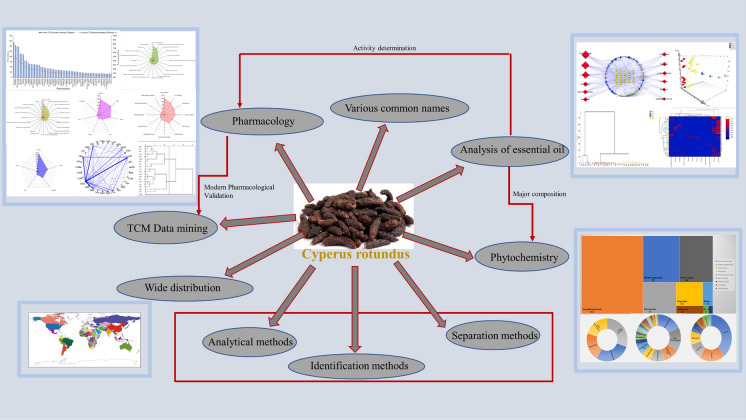- Record: found
- Abstract: found
- Article: not found
Phytochemistry, data mining, pharmacology, toxicology and the analytical methods of Cyperus rotundus L. (Cyperaceae): a comprehensive review

Read this article at
Abstract
Cyperus rotundus L. has been widely used in the treatment and prevention of numerous diseases in traditional systems of medicine around the world, such as nervous, gastrointestinal systems diseases and inflammation. In traditional Chinese medicine (TCM), its rhizomes are frequently used to treat liver disease, stomach pain, breast tenderness, dysmenorrheal and menstrual irregularities. The review is conducted to summarize comprehensively the plant’s vernacular names, distribution, phytochemistry, pharmacology, toxicology and analytical methods, along with the data mining for TCM prescriptions containing C. rotundus. Herein, 552 compounds isolated or identified from C. rotundus were systematically collated and classified, concerning monoterpenoids, sesquiterpenoids, flavonoids, phenylpropanoids, phenolics and phenolic glycosides, triterpenoids and steroids, diterpenoids, quinonoids, alkaloids, saccharides and others. Their pharmacological effects on the digestive system, nervous system, gynecological diseases, and other bioactivities like antioxidant, anti-inflammatory, anti-cancer, insect repellent, anti-microbial activity, etc. were summarized accordingly. Moreover, except for the data mining on the compatibility of C. rotundus in TCM, the separation, identification and analytical methods of C. rotundus compositions were also systematically summarized, and constituents of the essential oils from different regions were re-analyzed using multivariate statistical analysis. In addition, the toxicological study progresses on C. rotundus revealed the safety property of this herb. This review is designed to serve as a scientific basis and theoretical reference for further exploration into the clinical use and scientific research of C. rotundus.
Related collections
Most cited references193
- Record: found
- Abstract: found
- Article: not found
Antibacterial activity of selected fatty acids and essential oils against six meat spoilage organisms.
- Record: found
- Abstract: found
- Article: not found
Antidiabetic Potential of Flavonoids from Traditional Chinese Medicine: A Review
- Record: found
- Abstract: found
- Article: not found

